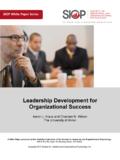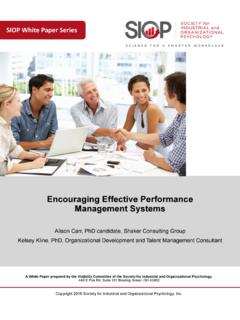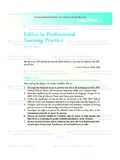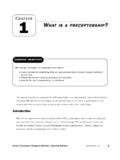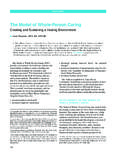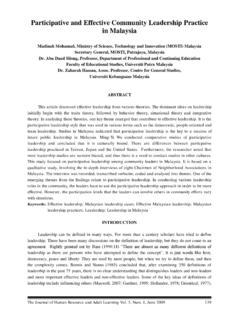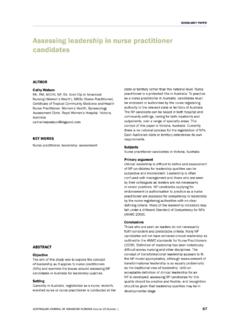Transcription of The Effect of Top Management Team Performance and …
1 The Effect of Top Management team Performance and Cohesion on Organizational Outcomes Aaron J. Kraus, Liberty Mutual Insurance Jared Z. Ferrell, Shaker SIOP White Paper Series A White Paper prepared by the Visibility Committee of the Society for Industrial and Organizational Psychology. 440 E Poe Rd, Suite 101 Bowling Green, OH 43402 Copyright 2016 Society for Industrial and Organizational Psychology, Inc. 2 SIOP White Paper Series Table of Contents Authors .. 3 Abstract .. 4 Introduction .. 4 Background .. 5 Implications for Practice .. 7 Next Steps .. 9 References .. 10 3 SIOP White Paper Series Authors Aaron Kraus Liberty Mutual Insurance Aaron Kraus is the Senior Program Manager with responsibility for Selection and Assessment at Liberty Mutual Insurance. Areas of applied expertise and responsi-bility include job analysis, the development, validation and implementation of selection systems, tools, and process, talent analytics, leadership development, as well as organization effectiveness and design.
2 Areas of research include determinants of innovation in organizations, dispelling myths about generational differences, the Effect of implicit bias on selection, predictors of innovative work behavior, and the drivers of job search behaviors. Jared Ferrell Shaker Jared Ferrell is a Senior Associate and team Leader for Shaker s Research and Development team . He has conducted research and ap-plied expertise in the areas of simulation scoring, equivalency of computer-based and mobile assessments, candidate experience, and advanced analytical methods. While at SHAKER, Jared has helped clients implement and continuously evaluate computer-based assessments to optimize the efficiency and effectiveness of hiring and promotional processes across a wide range of industries and roles. He also continues to present on innovative assessment practices and advanced analytical processes at annual professional conferences. 4 SIOP White Paper Series Abstract The current whitepaper examines research on top Management team attributes at both the individual ( , behavioral flexibility & leadership style) and team level ( , top Management team cohesion).
3 The direct and indirect mechanisms through which these characteristics impact organizational Performance will also be described. Introduction Executive leaders and top Management teams are critical to organizations perfor-mance. Top leaders formulate a collective purpose, instill values, influence culture, and determine the strategic plan for an organization, so they have significant influence on organizational outcomes. This influence has been quantified in previous studies to show that CEOs alone can account for about 29% of the overall variance in organiza-tional profitability (Mackey, 2008). This is nearly four times larger than the amount for which the corporation accounts (8%) and approximately five times larger than can be accounted for by industry (6%). Although CEOs are critical to an organization s Performance , research on top manage-ment teams suggests they have a much greater impact on organizational outcomes than the CEO alone (Mackey, 2008). Based on the strong relationship between top Management team functioning and organizational Performance , research has exam-ined the characteristics of CEOs and top Management teams that are most likely to facilitate organizational success.
4 Specifically, it has found that organizations can increase the likelihood of strong Performance by evaluating the behaviors, attributes, and leadership styles of CEOs and top Management teams, and linking these behaviors to their effects on organizational outcomes. The current whitepaper examines research on top Management team attributes at both the individual ( , behavioral flexibility & leadership style) and team level ( , top Management team cohesion). The direct and indirect mechanisms through which these characteristics impact organizational Performance will also be described. While research has suggested many other top Management team factors are related to 5 SIOP White Paper Series organizational Performance , behavioral flexibility, leadership styles, and top manage-ment team cohesion have a disproportionate impact on organizational Performance and can be improved through targeted development and are thus the primary focus here. Background Behavioral flexibility is the ability to change or adapt one s leadership style as necessary to meet current task demands or the needs of the constituency being addressed.
5 Behavioral flexibility is particularly important for top Management team members due to their role as strategic leaders (Boal & Hooijberg, 2000) who must constantly work with diverse stakeholders internal and external to the organization. Considering the multifaceted nature of their responsibilities, subordinates, and inter-actions, strategic leaders must demonstrate behavioral flexibility by adapting their leadership and communication styles to maximize the likelihood of favorable outcomes across these diverse settings and audiences (Boal & Hooijberg, 2000). Furthermore, the attributes of the top Management team often permeate the organi-zation as a whole, so having an adaptive top Management team is likely to make the organization more innovative, responsive, and therefore, more effective (Eisenbeiss et al., 2008). Various leadership styles have also been tied to organizational outcomes. Organiza-tions with top Management teams composed of charismatic and transformational leaders tend to perform better than organizations whose leaders do not possess these styles (Waldman, Ramirez, House, & Puranam, 2001).
6 Charismatic and trans-formational leaders effectively articulate a vision, earn the commitment of employees, and have a plan in the organization s best interests. These types of leaders are ideal to have during times of organizational stress or change and are associated with overall positive organizational outcomes (Waldman et al., 2001). This is because Charismatic leaders effectively provide clarity, generate support for change, and Strategic leaders must demonstrate behavioral flexibility by adapting their leadership and communication styles 6 SIOP White Paper Series engage in enterprise resource planning. Similarly, research on privately held compa-nies shows CEOs with transformational leadership styles increased organizational success by improving top Management team Performance (Ling, Simsek, Lubatkin, & Veiga, 2008). The strength of transformational leaders lies in inspiring creativity and innovation among employees and motivating them to accomplish more than what was thought to be possible.
7 However, transformational leadership is less effec-tive when used to clarify responsibilities and specify expectations, further illustrating the importance of behavioral flexibility and the ability to employ multiple types of leadership skills depending on situational cues. The process for selecting top Management team members requires more than mere-ly looking for someone with behavioral flexibility who demonstrates transformational and charismatic leadership styles. To maximize the likelihood of organizational suc-cess, top Management team composition also needs to be considered, because team -level factors such as cohesion also significantly affect firm Performance . Top Management team cohesion is a multidimensional construct that has been defined in a variety of ways, but the majority of the definitions describe team cohesion as a group level variable characterized by an attraction to a work group and the desire to remain part of it (Hogg, 1992). Cohesion is complex because it assesses the interac-tions of a group and reflects the unique attributes of members and their attraction to the work team .
8 Research has shown top Management team cohesion has a positive influence on organizational Performance and income growth (Peterson, Smith, Martorana, & Ow-ens, 2003). Instead of working individually or competitively against team members, cohesive top Management team members work together to accomplish goals, which helps maximize firm Performance . Furthermore, organizations with unified collective leadership are better able to initiate and follow through with substantive strategic The process for selecting top Management team members requires more than merely looking for someone with behavioral flexibility who demonstrates transformational and charismatic leadership styles. 7 changes compared with organizations that have faction-alized and less cohesive top Management teams (Peterson et al., 2003). Behavioral flexibility, leadership styles, and top manage-ment team cohesion have all been shown to positively impact organizational Performance . The next section de-scribes how organizations can select for and develop these three factors to optimize these critical attributes in top Management teams so they can maximize firm level Performance .
9 Implications for Practice Leadership styles can be developed at the individual level, and given the positive impact that charismatic and transformational leadership behaviors have on firm per-formance, they should be built into Management training and development programs. Such training should emphasize charismatic and transformational leadership behaviors that include articulating a vision for the future, fostering group-oriented work, setting high expectations, challenging followers thinking, supporting followers individual needs, and acting as a role model. At the individual level, executive leaders must have the behavioral flexibility to be both task-focused and relationship-focused, depending on the situation. Task-focused executives directly improve firm Performance by driving productivity and reducing ambiguity. Relationship-focused executives indirectly enhance organizational Performance by improving the attitudes of employees, subsequently driving improved organizational Performance .
10 To achieve optimal Performance the context of situations should serve as a cue to the top Management team as to whether they should be task or relationship-focused. Based on the importance of both types of focus, top Management teams that are trained in both task and relationship oriented leadership skills should be better able to recognize situations where one focus is more appropriate than the other. Such training could develop skills for task-focused leadership ( , monitoring behaviors, vision ar-ticulation, and risk evaluation) and relationship-focused leadership ( , communica-tion, benevolence, authoritativeness). The context of situations should serve as a cue to the top Management team as to whether they should be task or relationship-focused SIOP White Paper Series 8 SIOP White Paper Series When looking to select new leaders, candidates with strong behavioral flexibility as well as charismatic and transformational leadership styles should be given preferential consid-eration.
